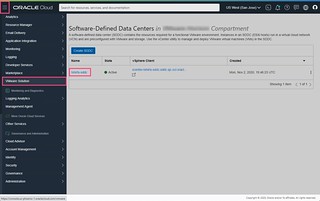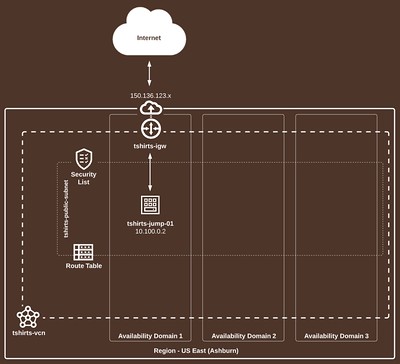In my recent ‘Getting started with Oracle Cloud VMware Solution (OVCS)’ post; Getting Started With Oracle Cloud VMware Solution (OCVS) – Connecting To An On-Premises Environment we set up hybrid connectivity between our on-premises vSphere environment and our OCVS SDDC allowing our on-premises workloads to communicate with workloads running in our workload overlay network.
Posts in this series:
In this blog post, which is the last blog post in this series, we are going to install VMware HCX in our on-premises vSphere environment and set up a site-pairing between our on-premises environment and our OCVS SDDC. Once we have HCX configured, we will test our connectivity by migrating workloads between our sites. We will also configure an extended network between both sites using HCX. This allows virtual machines to move between sites without the need to change IP addresses.
NOTE: As this is not a HCX focused post, we will not be going into the details of how we configured our HCX service mesh. If you are not familiar with configuring HCX, I’d recommend following VMware’s official documentation: VMware HCX User Guide.
Here is a high-level diagram of what we are going to be configuring.
 Read the rest of this entry »
Read the rest of this entry »
In my recent ‘Getting started with Oracle Cloud VMware Solution (OVCS)’ post; Getting Started With Oracle Cloud VMware Solution (OCVS) – Connecting To Oracle Cloud Infrastructure Services we deployed a Windows Server into our OCVS SDDC and connected it, using NFS, to an OCI File System that will be used to store files and folders for our users.
Posts in this series:
In this blog post, we are going to look at connecting our OCVS SDDC environment to our on-premises vSphere environment, so that our workloads in both environments can communicate with each other. There are two main ways of connecting OCVS to an on-premises environment. Oracle FastConnect or Oracle VPN Connect. In my environment, I will be using an Oracle FastConnect connection provided by Megaport. As there are many other ways of setting up a FastConnect via other services, I will not document that section step-by-step.
Here is a high-level diagram of what we are going to be configuring.
 Read the rest of this entry »
Read the rest of this entry »
In my recent ‘Getting started with Oracle Cloud VMware Solution (OVCS)’ post; Getting Started With Oracle Cloud VMware Solution (OCVS) – Networking Configuration we familiarized ourselves with the OCVS networking configuration, including NSX-T. Now that we have a better understanding of how the networking is configured within the environment, we can start to look at connecting our workloads running within our OCVS SDDC to other Oracle Cloud Infrastructure (OCI) Services.
Posts in this series:
In this blog post were are going to deploy a Windows Server into our SDDC and connect it to an OCI File System that will be used to store files and folders for our users. This is a very simple example chosen to illustrate how easy it is to connect OVCS workloads to OCI services. This is a high-level diagram of what we are going to be configuring.
 Read the rest of this entry »
Read the rest of this entry »
In my recent ‘Getting started with Oracle Cloud VMware Solution (OVCS)’ post; Getting Started With Oracle Cloud VMware Solution (OCVS) – Deploying The SDDC With HCX we deployed ourselves a Software-Defined Data Center (SDDC) along with VMware HCX into Oracle Cloud.
Posts in this series:
In this post, I’m going to review the overall networking configuration, including NSX-T.
ESXi Host ‘Oracle Cloud’ Connectivity
First, let’s take a look at how the ESXi Hosts are connected to the Oracle Cloud infrastructure.
- Login to the OCVS console
- Select the correct Region. (This should be the same region that the SDDC and the Bastion host were deployed)
- Click on the burger icon at the top left of the screen to display the menu
- Scroll down on the left-hand side menu and select VMware Solution
- Select the name of your newly deployed SDDC
- Scroll down to the ESXi Hosts section
- Select one of the ESXi Hosts (Compute Instance column)
- Scroll down to the Metrics section
- Select Attached VNICs on the Resources menu (left-hand side of the page)

Here we can see virtual network interfaces, Subnets, and VLANs that are attached to the ESXi Host. The following diagram illustrates a single ESXi Host’s connectivity to the various VLANs deployed as part of the SDDC configuration. As we go through the networking configuration, the diagram will begin to make more sense.
 Read the rest of this entry »
Read the rest of this entry »
In the most recent ‘Getting started with Oracle Cloud VMware Solution (OVCS)’ post; Getting Started With Oracle Cloud VMware Solution (OCVS) – Deploying The SDDC With HCX we deployed ourselves a VMware vSphere Software-Defined Data Center (SDDC) along with VMware HCX into Oracle Cloud.
Posts in this series:
In this post, I’m going to do a high-level review of the SDDC deployment which includes the VMware vSphere components (vCenter, ESXi Hosts), NSX-T Manager, and VMware HCX. Subsequent posts will dive deeper into the configuration.
SDDC Deployment Overview

- Login to the OCVS console
- Select the correct Region, this should be the same region that the SDDC and Bastion host were deployed into
- Click on the burger icon at the top left of the screen to display the menu
- Scroll down on the left-hand side menu and select VMware Solution
- Select the name of your newly deployed SDDC
We are now presented with the SDDC information. This page contains all of the important URLs, IP Addresses, Usernames, Passwords that you’ll need to access and manage your environment.
 Read the rest of this entry »
Read the rest of this entry »
Following on from my recent post; Getting Started With Oracle Cloud VMware Solution (OCVS) – Deploying A Bastion Host which documents the steps needed to deploy a bastion host on Oracle Cloud, that will be used to access our OCVS SDDC. We can now deploy the SDDC, including VMware HCX (optional).
Posts in this series:
As you will see, the deployment process is very simple and straightforward. Once we have successfully deployed the SDDC and HCX, in the next blog post in this series, we’ll take a closer look at how the solution is deployed within Oracle Cloud.
Prerequisites
- SSH Keys
During the deployment of our bastion host, we created a set of keys (public and private) that were used to access the bastion host via SSH. The same approach is used with the ESXi hosts in the SDDC. Instead of providing a root password, we need to supply our public key.
Deploying the SDDC
 Read the rest of this entry »
Read the rest of this entry »
As part of my new role at VMware, I recently got access to Oracle Cloud VMware Solution (OCVS as it’ll be called from now on) to check out their solution and begin to understand how it all works. If you aren’t familiar with OCVS, you can read more about it here; Oracle Cloud VMware Solution
As part of my discovery and learning process, I thought I would try and share some of my thoughts and findings as I go about learning this new, cool, solution.
Posts in this series:
By default, after deployment, the OCVS SDDC is not available directly via the internet, which means my first task is to deploy a bastion host that will be used to enable external access into the Oracle Cloud environment. While the process isn’t complicated, I thought I’d document the process step-by-step, to make it easier for others in the future. I used this official Oracle Cloud Bastion Host document as a guide throughout the process. (Note: A bastion host may not be required if you are using an Oracle FastConnect or an IPSec VPN to securely connect to the Oracle Cloud environment.)
When it comes to bastion hosts, there are many options for you to choose from. In this post, I’ll only document how to deploy a Linux virtual machine which can then be used to provide an SSH Tunnel, or used to install Apache Guacamole onto. If you really wanted to, you could deploy a Windows server and RDP to that instead. The type of bastion host you use is entirely up to you.
Below is a simple diagram of how the environment will be configured at the end of this post. I’ll have a single virtual server (bastion host) that is available on the internet via a public IP address.
 Read the rest of this entry »
Read the rest of this entry »
In the past few months, there has been a surge in public cloud providers announcing their hosted VMware Cloud Foundation services. Here are a few examples:
In an attempt to try and keep up with the various cloud services that are becoming available, I’ve created the following page: Comparison: Public Cloud-Hosted – VMware Cloud Foundation Services to help me learn more about each individual service offering. Data on each service has been collected in order to have data points from all service providers available in a single place.
At the moment, the table includes information from the following cloud services:
The page will evolve over time as new services/features become available, so follow me twitter @Simonlong_ for updates. If a cell is empty it’s because I haven’t been able to find the information yet. If you notice any incorrect information, please contact me via twitter @Simonlong_ and I will do my best to update ASAP.










